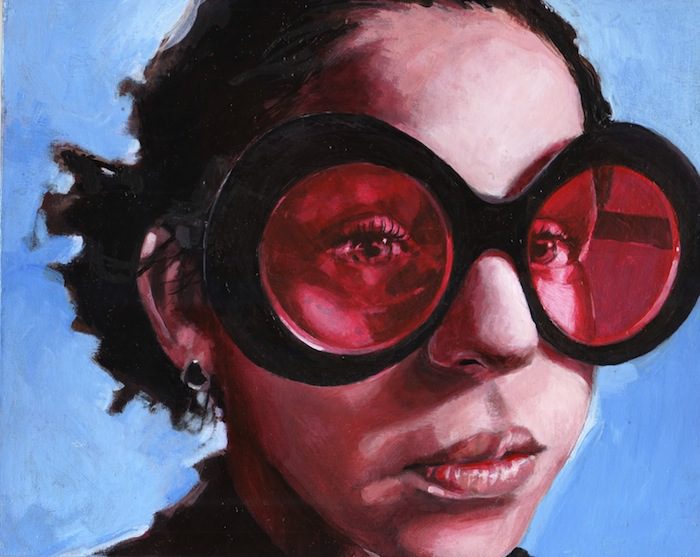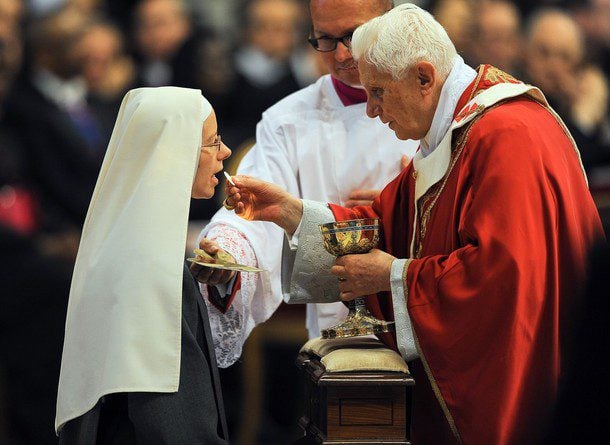
As the New Translation of the English Missal nears, I am getting more and more pumped about the Liturgy. It is the greatest thing since sex. (And I do not mean that flippantly; the marital union is but a shadow of the union attained at the wedding feast between Heaven and Earth.)
But alas and alack and areallylame, these seem to be the days when one must ‘pick sides’ in regards to the Liturgy, between the (what?) Traditionalists? Conservative Catholics? Latin-Massers? and the (who?) Modernists? Charismatics? Liberals?

But it is the falsest of dichotomies. I speak with a severe lack of knowledge of all the various encyclicals, council decisions, etc. but I do bring to the table the experience of a child who has grown up amidst this conflict. And I know this: Now is the time to mend the wound. Now, following the example of our beloved, peace-making Pope, is the time to lay down our factional weapons and learn what it is to be Catholic. This means all of us, from the “Latin-is-the-only-language-acceptable-for-the-Mass!”, “Organ-or-death!”, “The Novus Ordo is heretical!” folks, to the “Vatican II lets us do what we want with the liturgy!”, “Whatever leads me to Jesus is good for the Mass!” people.
Take my favorite example; Music in the Liturgy. The two ‘sides’ split up as follows. On the one hand, Gregorian Chant has pride of place, and therefore it – along with various traditional hymns – is all that should be allowed in the liturgy. On the other: Any music that glorifies God should be allowed in the Liturgy, so break out the mandolin, we gone have a FOLK MASS!
But both views ignore the Liturgy. The first points out the Church’s extolment of Gregorian Chant – rightfully so – and then makes one projection; it is all that should be used, and avoids one question: Why is Gregorian Chant given pride of place?
The second projects a complete falsehood onto the Liturgy. Rap music can glorify God. As can naked dancing. That doesn’t mean it belongs in the Liturgy. We should never seek to ‘put things into’ the Mass, for the Mass is a gift. We receive it. We conform to it, it does not conform to us, nor to our age. Thus it is absolutely wrong to have a ‘contemporary’ Mass, or to have a ‘modern music’ Mass. It’d be akin to receiving a painting from a friend, and drawing on it with a Sharpie all that you’d like to be included in it. Only to an infinite degree, for which you will inevitably be all up and smited upon by a thunderous, frowning Deity.
The reality does not simply lie between these two opposing views; it is the center that these views ripple from. The reality is that the Mass, being a gift from God, does not deserve some particular genre or style of music, or some age of music. It deserves objectively beautiful music that allows for contemplation. Gregorian chant is given pride of place because it has proven itself to fulfill those terms. But that in no way excludes other forms of music fulfilling those terms. Thus secular instruments – the guitar, piano etc. – are in no way banned by the Church; they are allowed with a strict warning, that if they are played…
“…they are to be played with such seriousness, and religious devotion that every suggestion of raucous secular music is avoided, and the devotion of the faithful is fostered” (Sacred Congragation Of Rites 1958)
Speaking truthfully, most use of secular instrumentation in the Liturgy I am aware of fails to live up to this call. But that does not mean it has to. There’s a particularly gorgeous modern hymn, How Deep the Father’s Love For Us, that I firmly believe can not only meet the requirements of the Church, but also foster a beautiful devotion within the faithful during the Holy Mass. (Obviously a lot depends on how it is played, as is the case with Chant).
The Traditionalist cannot ignore this fact, unless he pick his favorite Church documents and ignores the others. But I’ve lingered too long on the subject of music. Do you see the point? The New Translation gives us a fantastic opportunity to fall madly in love with the Liturgy as it is, not as we’d like it.
Come Advent, we will begin saying goodbye! to the response “and also with you,” and will replace it with the accurate translation “and with your spirit.” In this small translation a great truth is found. We are rejecting what some wanted the Liturgy to be, or thought it would be fine for the Liturgy to be, and are humbling ourselves to accept what the Liturgy is. It is a gift from God.
replace it with the accurate translation “and with your spirit.” In this small translation a great truth is found. We are rejecting what some wanted the Liturgy to be, or thought it would be fine for the Liturgy to be, and are humbling ourselves to accept what the Liturgy is. It is a gift from God.
I’ll be posting on the Liturgy for a good bit after this, in anticipation of the New Translation. Use this renewal within the Church as a time of self-examination, of scrupulously, honestly, and painfully facing the ways we project ourselves onto the Liturgy. And then put an end to them! Now is the time to heal the division within the Church, and move with Her into an age of greater unity. What great work we could do in the world, if we presented to it an unshakeable unity of purpose and mind.











